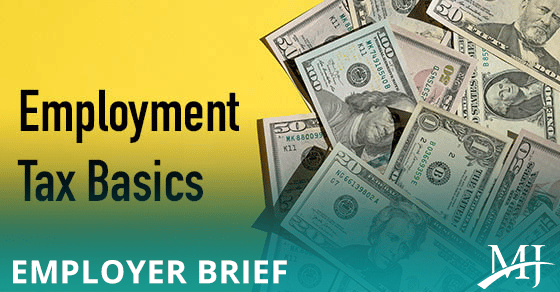What are the requirements for employers regarding federal employment taxes? This might seem like a silly question to ask of employers, many of which have been grappling with this obligation for years or even decades.
But, just as a coat of paint sometimes needs freshening up, it’s not a bad idea to occasionally review the basics of employment taxes to see whether your organization’s processes are at risk of missing any key steps, which could lead to costly penalties.
Form 941
Employers must report and deposit certain employment taxes regularly. These include:
- Federal income tax withholding (FITW),
- Social Security tax (both the employer and employee portion),
- Medicare tax,
- Additional Medicare tax, and
- Federal unemployment tax (FUTA).
Typically, an organization reports FITW, Social Security, Medicare and Additional Medicare taxes on Form 941, “Employer’s Quarterly Federal Tax Return.” FUTA is reported on Form 940, Employer’s Annual Federal Unemployment (FUTA) Tax Return.
True to its name, Form 941 is filed quarterly and due by the last day of the month following the end of each quarter. Typically, the due dates for filing this form are:
- April 30 (first quarter),
- July 31 (second quarter),
- October 31 (third quarter), and
- January 31 (fourth quarter).
If any deposit due date falls on a Saturday, Sunday or legal holiday, you may deposit on the next business day.
For smaller employers with a low employment tax liability, the IRS will allow for the annual deposit and filing of these taxes. Such employers use Form 944, “Employer’s Annual Federal Tax Return.”
Employment tax deposits
While Form 941 is filed quarterly, employment tax deposits are typically submitted more frequently unless the employer is a Form 944 filer. This frequency can either be semiweekly or monthly. Which one is determined through a “lookback period.” This is the total tax liability for an employer for the previous four quarters — July 1 of the second preceding calendar year through June 30 of the preceding calendar year.
If an employer reports $50,000 or less of Form 941 taxes for the lookback period, it’s a monthly schedule depositor. On the other hand, if an employer reports more than $50,000, it’s a semiweekly schedule depositor.
A notable exception
An exception applies to these deposit schedules if an employer accumulates tax liability of $100,000 or more on any day during a deposit period. This often happens around bonus time for some employers or when pay increases kick in.
When this happens, the employer must deposit the tax by the close of the next business day, regardless of whether the employer is a monthly or semiweekly depositor. And if the employer is a monthly depositor, it becomes a semiweekly depositor.
Maintain your processes
If all of this sounds completely obvious, that’s a good thing! Your organization is likely on top of its employment tax obligations. Nonetheless, keep a close eye on these processes to ensure they don’t fall into disrepair. Contact us for more information on either the basics or more complex matters related to payroll or employment taxes.
© 2022




